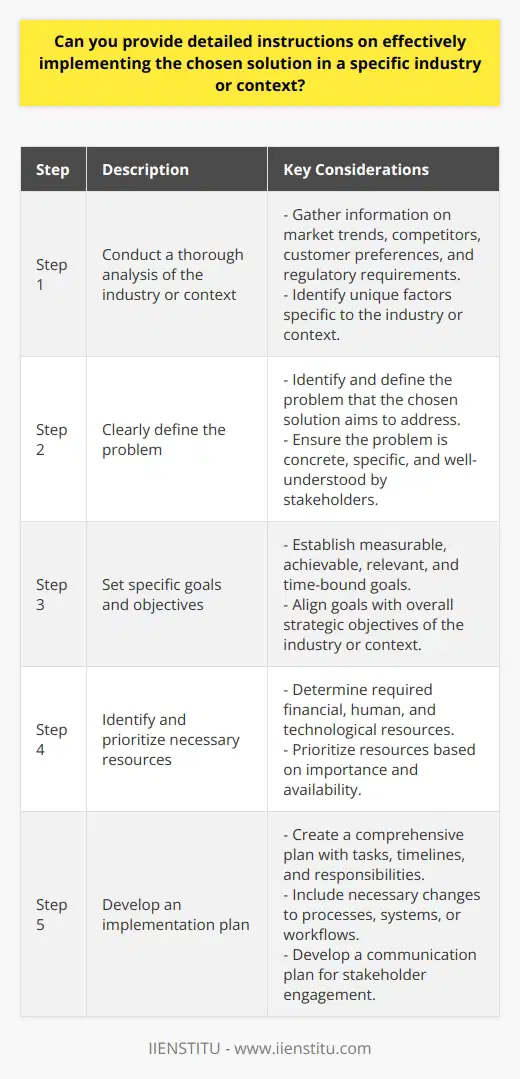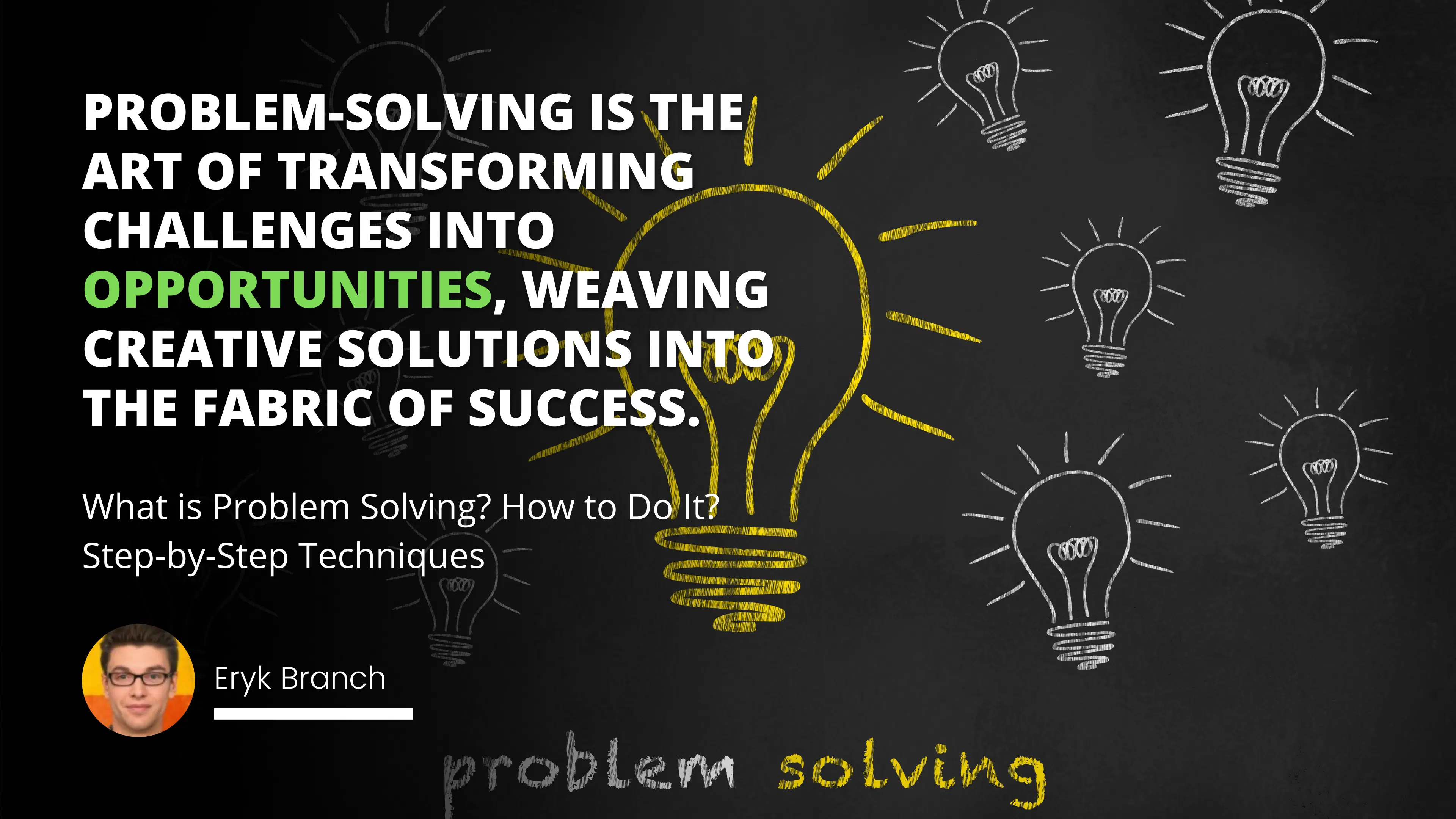
In today's complex and rapidly changing world, problem-solving skills have become indispensable for individuals and organizations. These skills are crucial for navigating the myriad challenges we face in various aspects of our lives, personal, professional, or societal. As a cognitive process, problem-solving involves identifying and analyzing difficulties, generating potential solutions, and implementing effective strategies to overcome them.
In this blog post, we will delve into problem-solving, elucidate its significance, and provide a step-by-step guide to mastering the art and science of problem-solving techniques. The tone of this article will remain academic, focusing on giving well-researched and practical information to aid our understanding and application of this essential skill.
What is Problem Solving?
Problem-solving is a cognitive process that involves identifying, analyzing, and resolving challenges or obstacles in various aspects of life, including personal, professional, and societal situations. It is a crucial skill for successfully navigating the complexities of everyday life and making well-informed decisions.
The process of problem-solving typically consists of several stages:
Problem identification: Recognizing that a problem exists and understanding its nature.
Problem analysis: Gathering information and examining the problem to understand its underlying causes and constraints.
Generating solutions: Brainstorming and evaluating potential solutions, considering different approaches, and selecting the most viable ones.
Implementing solutions: Putting the chosen solutions into action and monitoring their effectiveness.
Evaluating outcomes: Assessing the results of the implemented solutions, determining if the problem has been resolved, and making adjustments as necessary.
Problem-solving can be approached through various methods and techniques, such as analytical, creative, or systematic thinking, depending on the nature of the problem and the context in which it is presented. Developing practical problem-solving skills requires practice, critical thinking, and adapting to changing circumstances.
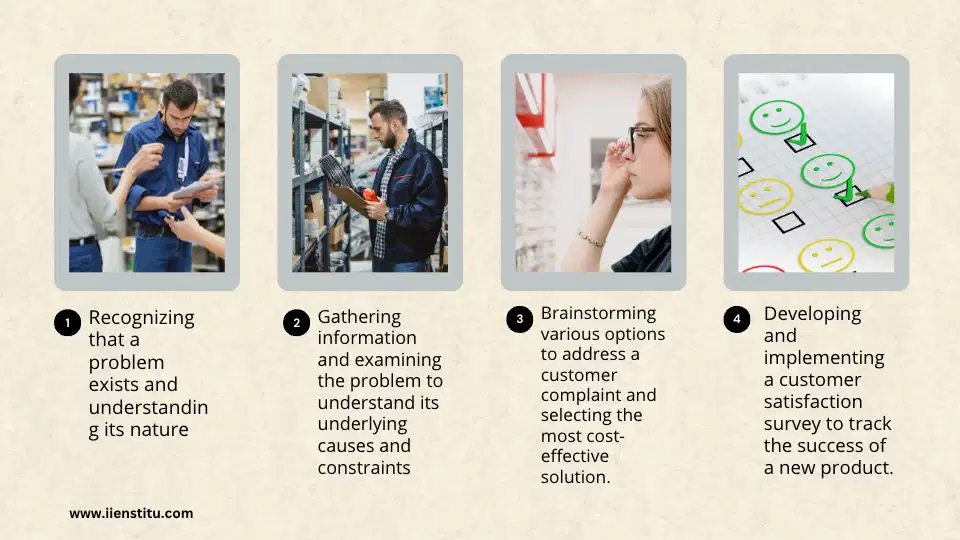
Critical Chain Project Management: Enhancing Efficiency in Task Execution
Risk Mitigation: An Essential Strategy for Successful Project Management
Problem-solving is the art of transforming challenges into opportunities, weaving creative solutions into the fabric of success.
What are problem-solving skills?
Problem-solving skills are a set of cognitive, interpersonal, and practical abilities that enable individuals to effectively identify, analyze, and resolve challenges they encounter in various aspects of life. These skills are essential for making well-informed decisions, overcoming obstacles, and achieving personal and professional goals. Some critical problem-solving skills include:
Analytical thinking: The ability to break down complex problems into smaller, manageable components, examine their relationships and understand underlying causes and patterns.
Critical thinking: The capacity to objectively evaluate information, identify biases, question assumptions, and determine the relevance and reliability of available data.
Creative thinking: The ability to generate innovative ideas, explore unconventional approaches, and combine existing concepts in novel ways to develop effective solutions.
Decision-making: Choosing the most suitable solution from available options based on careful analysis, evaluation, and prioritization.
Communication: The capacity to effectively convey and receive information, listen actively, ask pertinent questions, and collaborate with others to address problems.
Adaptability: The ability to adjust to changing circumstances, cope with ambiguity, and modify strategies as new information becomes available or conditions evolve.
Emotional intelligence: The skill of recognizing, understanding, and managing one's emotions and those of others, which can influence the problem-solving process and its outcomes.
Implementation and monitoring: The ability to implement chosen solutions, monitor their effectiveness, and make necessary adjustments to improve results.
Developing strong problem-solving skills requires practice, self-reflection, and a willingness to learn from experience. By honing these skills, individuals can more effectively tackle challenges and achieve their objectives in various aspects of life.
Problem-solving skills are the keys that unlock life's complex doors, paving the way to innovation, growth, and success
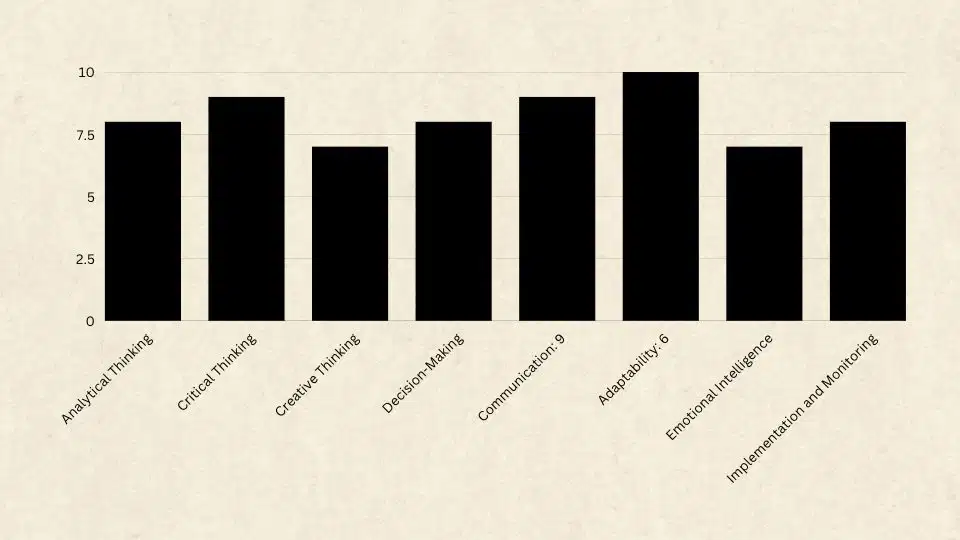
How to Improve Your Problem-Solving Skills?
Improving your problem-solving skills involves developing your cognitive, interpersonal, and practical abilities to tackle challenges effectively and make well-informed decisions. Here are some strategies to enhance your problem-solving skills:
Practice active learning: Engage in activities that challenge your thinking and require you to solve problems, such as puzzles, riddles, or brainteasers. Pursue new knowledge, skills, and experiences to expand your understanding of different subject areas and perspectives.
Develop critical thinking: Cultivate the habit of questioning assumptions, evaluating evidence, and considering multiple viewpoints. Learn to identify logical fallacies, biases, and inconsistencies in reasoning.
Foster creativity: Engage in activities encouraging creative thinking, such as brainstorming, mind mapping, or artistic pursuits. Embrace a growth mindset and be open to new ideas and perspectives.
Strengthen decision-making abilities: Practice making decisions based on careful analysis, evaluation, and prioritization of available information. Reflect on past decisions to learn from successes and failures.
Enhance communication skills: Develop active listening, effective questioning, and precise expression abilities. Participate in group discussions or join clubs that involve collaborative problem-solving activities.
Cultivate adaptability: Embrace change and be prepared to adjust your strategies as new information becomes available or conditions evolve. Learn from your experiences and be open to feedback.
Build emotional intelligence: Develop self-awareness and learn to manage your emotions during problem-solving. Practice empathy and understand the feelings and perspectives of others involved in problem-solving.
Reflect on your experiences: Regularly assess your problem-solving skills by analyzing your successes and failures. Identify areas where you excel and areas that need improvement. Seek feedback from peers, mentors, or supervisors to gain insights into your performance.
Set SMART goals: Establish specific, measurable, achievable, relevant, and time-bound goals for improving your problem-solving skills. Monitor your progress and adjust your strategies as needed.
Learn from others: Observe how others approach problem-solving, especially those skilled in this area. Seek mentorship or participate in workshops, seminars, or online courses on problem-solving techniques and strategies.
By consistently practicing and refining these strategies, you can gradually improve your problem-solving skills and become more adept at addressing challenges in various aspects of your life.
Sharpen your problem-solving prowess by embracing curiosity, cultivating adaptability, and seeking diverse perspectives – the keys to unlocking life's complex puzzles.
The Problem-Solving Process: A Comprehensive Guide
In today's fast-paced and dynamic world, individuals and organizations face challenges requiring practical problem-solving abilities. To navigate these complexities and make well-informed decisions, it is crucial to have a structured approach to identifying, analyzing, and addressing issues. The problem-solving process is a framework for systematically tackling problems and ensuring successful outcomes. In this blog section, we will explore the various stages of the problem-solving process, discuss their importance, and provide valuable insights to help you master this essential skill. By comprehensively understanding this process, you can enhance your problem-solving abilities and achieve tremendous success in your personal and professional life.
Define the Problem: The Foundation of Effective Problem Solving
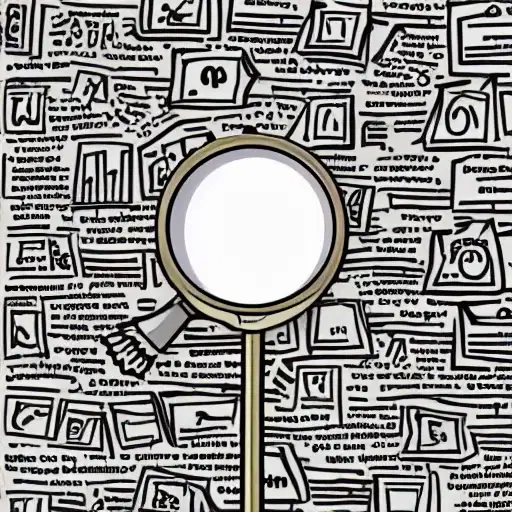
The first and arguably most critical step in the problem-solving process is defining the problem. An apparent, well-defined problem is the foundation for all subsequent stages, allowing you to understand the issue at hand better and develop targeted solutions. To effectively define the problem, you should gather relevant information, identify the root causes and constraints, and distinguish between the symptoms and the underlying issues.
Begin by asking open-ended questions to explore the problem's context and dimensions. For instance, consider questions such as: What are the symptoms of the issue? Who is affected by the problem, and how does it impact them? What are the potential causes? What factors or conditions contribute to the problem's existence? Additionally, it can be helpful to consider the situation from various perspectives, including those of the stakeholders involved.
Once you have gathered sufficient information, articulate the problem as a clear, concise statement summarizing the issue and its key elements. A well-defined problem statement provides a solid basis for further analysis and solution generation, helps maintain focus, and ensures that your problem-solving efforts are directed toward addressing the core issue. In addition, investing time and effort in defining the problem sets the stage for a more efficient and effective problem-solving process.
Generate Alternative Solutions: Unlocking the Potential of Diverse Approaches
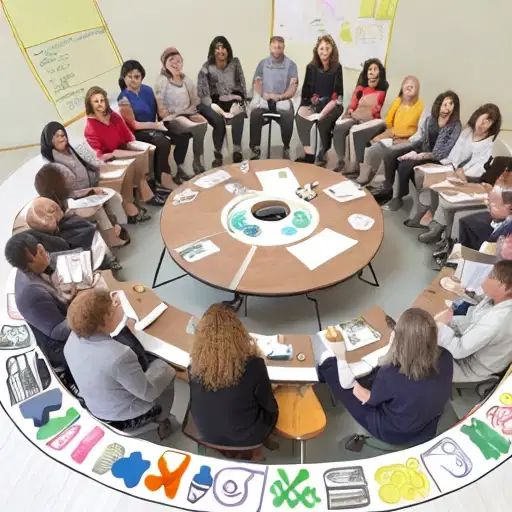
The second stage in the problem-solving process, generating alternative solutions, is essential for developing a comprehensive understanding of the available options and ensuring that the most effective solution is ultimately selected. This stage encourages creative thinking, challenging assumptions, and considering various perspectives to identify a wide range of potential solutions that address the problem.
To generate alternative solutions, employ brainstorming techniques, such as mind mapping, the Six Thinking Hats method, or the SCAMPER technique. These approaches can help you explore different angles, stimulate creativity, and tap into the collective knowledge of team members or stakeholders. In addition, it encourages open-mindedness and promotes an environment where unconventional ideas and diverse viewpoints are welcomed.
While generating solutions, resist the urge to evaluate or judge the ideas immediately. Instead, focus on creating a comprehensive list of possible solutions without discarding any options prematurely. Quantity, at this stage, is often more important than quality, as it allows you to consider a wide range of possibilities.
Once you have generated an extensive list of potential solutions, you can move on to the next stage of the problem-solving process, which involves evaluating, comparing, and prioritizing the alternatives. Again, investing time and effort in generating alternative solutions increases the likelihood of finding the most effective and innovative approach to addressing the problem.
Evaluate and Select an Alternative: Choosing the Optimal Solution

After generating diverse potential solutions, the next step in the problem-solving process is to evaluate, compare, and ultimately select the most appropriate alternative. This stage thoroughly assesses each option, considering its feasibility, effectiveness, resource requirements, and potential consequences. Then, by systematically evaluating the other options, you can make an informed decision that best addresses the problem and aligns with your objectives.
To evaluate and select an alternative, consider the following steps:
Establish evaluation criteria: Identify the factors most relevant to the problem and your goals. These may include cost, time, resources, stakeholder impact, risks, or potential benefits. Ensure that the criteria are measurable and specific to facilitate objective comparisons.
Rank the alternatives: Assess each solution against the established criteria, assigning scores or ratings based on performance. This can be done using various techniques, such as decision matrices, cost-benefit analysis, or risk assessment models. These methods can help you systematically compare the options and determine their relative strengths and weaknesses.
Weigh the trade-offs: Recognize that each solution may have its advantages and drawbacks, and it is essential to balance these factors. Consider each alternative's short-term and long-term consequences and the potential risks and uncertainties associated with their implementation.
Prioritize and select: Based on the evaluation, prioritize the alternatives and choose the one that best meets the criteria, addresses the problem effectively, and aligns with your goals. Remember that sometimes, a combination of solutions may be more effective than a single approach.
Seek feedback and validation: Consult with stakeholders, team members, or subject matter experts to validate your choice and gather additional insights. This helps ensure that the selected solution is well-founded and has the support of those affected by the problem.
By carefully evaluating and selecting an alternative, you can confidently move forward in the problem-solving process, knowing that you have chosen the most effective and well-suited solution to address the issue.
Implement and Follow Up on the Solution: Ensuring Success and Continuous Improvement

With the optimal solution selected, the next stage in the problem-solving process is implementing the chosen alternative and monitoring its effectiveness. This stage involves implementing the key, managing resources, and ensuring the desired outcomes. Finally, following up on the solution allows you to assess its success, identify areas for improvement, and make necessary adjustments to enhance results.
To effectively implement and follow up on the solution, consider the following steps:
Develop an implementation plan: Outline the steps required to put the solution into action, including timelines, resource allocation, and responsibilities. Establish clear objectives, milestones, and performance indicators to measure progress and success.
Communicate and engage stakeholders: Inform relevant stakeholders about the chosen solution, its rationale, and the implementation plan. Engage them in the process, and address any concerns or questions. This can help to ensure buy-in and facilitate a smoother implementation.
Monitor progress: Regularly track the implementation of the solution against the established milestones and performance indicators. Assess whether the desired outcomes are achieved and any unforeseen challenges or obstacles that have emerged.
Evaluate results: Once the solution has been implemented, evaluate its effectiveness in addressing the problem. Consider both quantitative and qualitative data to assess the impact of the solution on the issue and its related aspects.
Make adjustments as needed: If the results indicate that the solution is not as effective as anticipated or if new information becomes available, be prepared to make adjustments or revisit the problem-solving process. This may involve refining the solution, implementing an alternative, or exploring additional options.
Reflect on the process: Analyze the problem-solving process to identify any lessons learned or areas for improvement. This can enhance your problem-solving skills and increase the likelihood of success in future endeavors.
By implementing and following up on the solution, you can ensure that the problem is effectively addressed and that continuous improvement is achieved. This proactive approach to problem-solving increases the chances of success and fosters a growth mindset and a commitment to excellence.
Discovering the World of Problem Solving: A Treasure Trove of Resources
Embarking on the journey to enhance your problem-solving skills requires diverse resources to guide and inspire you. From foundational literature to practical case studies, certifications, and multimedia learning experiences, there are abundant materials to help you build your expertise. This section will explore a captivating collection of resources to enrich your understanding of problem-solving strategies and techniques.
Unraveling the Mysteries of Problem-Solving: Books Worth Reading
Delve into the world of problem-solving with essential books authored by renowned experts, offering valuable insights, methodologies, and real-life examples. These comprehensive texts will equip you with the knowledge and tools to address complex challenges and improve your decision-making abilities.
Diving into Scholarly Wisdom: Engaging Articles
Stay up-to-date with the latest research and developments in problem-solving by reading scholarly articles from reputable journals and publications. These articles provide fresh perspectives, empirical findings, and cutting-edge approaches to enhance your problem-solving expertise.
Learning from Real-Life Experiences: Captivating Case Studies
Gain practical knowledge and inspiration from case studies showcasing real-world examples of practical problem-solving. These stories offer valuable lessons and insights into how individuals and organizations have successfully tackled challenges using innovative solutions and strategies.
Mastering the Art of Problem-Solving: Pursuing Certification
Pursue industry-recognized certifications to validate your problem-solving skills and demonstrate your proficiency to employers, colleagues, and clients. In addition, these certifications can enhance your credibility and open doors to new opportunities in your personal and professional life.
Expanding Your Horizons: Engaging Courses
Enroll in online or in-person courses to deepen your understanding of problem-solving techniques and gain hands-on experience with practical exercises and simulations. These structured learning opportunities allow you to learn from experts, collaborate with peers, and apply your newfound skills in real-life scenarios.
Embracing the Digital Age: Informative Webcasts
Discover a wealth of knowledge at your fingertips with webcasts featuring renowned experts and thought leaders discussing various problem-solving aspects. These digital presentations offer an interactive and convenient way to learn, allowing you to engage with presenters, ask questions, and explore topics in-depth from the comfort of your home or office.
By exploring these diverse and engaging resources, you can build a solid foundation in problem-solving, refine your skills, and unlock your full potential as a practical decision-maker and problem-solver.
Embark on the journey through the realm of problem-solving, where each challenge conquered unlocks a treasure chest of wisdom, growth, and success
Expanding the Scope of Problem-Solving: Versatile Applications Across Diverse Sectors and Professions
Problem-solving techniques are essential to success across all industries and fields of work. Businesses, organizations, and individuals use problem-solving skills to tackle challenges, make decisions, and develop strategies to achieve their goals. Here are some sectors where problem-solving techniques can be applied:
Business and management: In the business world, problem-solving can be applied in project management, process improvement, strategic planning, and decision-making.
Engineering and technology: Engineers and technicians use problem-solving techniques to design, develop, and troubleshoot various systems, products, and processes. This can include civil, mechanical, electrical, and software engineering.
Healthcare professionals use problem-solving skills to diagnose and treat patients, manage healthcare systems, and develop new treatments and medical technologies.
Education: Educators and administrators apply problem-solving strategies to develop and implement effective teaching methods, manage classrooms, and address challenges within the educational system.
Finance and economics: Financial analysts, economists, and other professionals use problem-solving techniques to analyze economic trends, manage investments, and develop financial strategies for individuals and organizations.
Science and research: Scientists and researchers employ problem-solving skills to design experiments, interpret data, and develop new theories and solutions in various fields, including physics, chemistry, and biology.
Public sector and government: Public administrators and policymakers use problem-solving techniques to address societal challenges, develop and implement public policies, and manage government programs and services.
Non-profit and social work: Professionals in non-profit organizations and social work apply problem-solving strategies to address social issues, develop programs, and provide services to those in need.
Arts and creative industries: Artists, designers, and other creative professionals use problem-solving techniques to develop innovative ideas, create compelling works of art, and navigate the challenges of their industries.
Law and legal practice: Lawyers, judges, and other legal professionals use problem-solving skills to interpret laws, analyze cases, and develop legal strategies for their clients.
Marketing and advertising: Professionals in marketing and advertising use problem-solving techniques to develop innovative campaigns, analyze market trends, and optimize advertising strategies for better audience engagement.
Human resources: HR professionals apply problem-solving skills to manage employee relations, develop training programs, resolve workplace conflicts, and create effective recruitment strategies.
Environmental and sustainability: Experts in environmental management, conservation, and sustainability use problem-solving techniques to address ecological challenges, develop sustainable practices, and implement environmental policies.
Agriculture and food production: Farmers, agronomists, and professionals use problem-solving skills to optimize crop yields, manage pests and diseases, and develop innovative farming techniques.
Real estate and urban planning: Real estate professionals and urban planners employ problem-solving techniques to address issues related to land use, zoning, property management, and urban development.
Logistics and supply chain management: Logistics and supply chain management professionals use problem-solving skills to optimize transportation routes, manage inventory levels, and improve overall efficiency in moving goods.
Manufacturing and production: Manufacturing professionals apply problem-solving techniques to streamline production processes, enhance product quality, and reduce waste.
Sports and fitness: Coaches, trainers, and athletes use problem-solving skills to develop training programs, improve performance, and address challenges related to physical fitness and athletic competition.
Hospitality and tourism: Professionals in the hospitality and tourism industry apply problem-solving strategies to enhance customer experiences, manage operational challenges, and develop new services and offerings.
Information and library services: Librarians and information specialists use problem-solving techniques to manage collections, develop information retrieval systems, and address challenges in accessing and preserving knowledge resources.
These additional examples highlight the universality of problem-solving techniques, emphasizing their importance across various sectors, professions, and contexts. Cultivating problem-solving skills can significantly contribute to personal and professional success, regardless of the field or industry.
Mastering the Art of Problem-Solving: A Six-Step Guide to Conquering Challenges
In today's fast-paced world, solving problems effectively is essential for personal and professional success. Whether tackling a complex project at work or navigating life's everyday hurdles, following a structured approach can make all the difference. This blog post will explore a six-step guide that will empower you to address challenges confidently and develop creative solutions.
Step 1: Define the Problem
The first step in any problem-solving process is clearly defining the problem at hand. Begin by identifying your issue, and try articulating it as accurately and precisely as possible. Next, consider any underlying causes, constraints, or factors influencing the situation. You can lay a solid foundation for developing practical solutions by thoroughly understanding the problem.
Step 2: Generate Possible Solutions
Once you clearly understand the problem, it is time to brainstorm potential solutions. At this stage, encourage creativity and open-mindedness, and avoid prematurely judging or dismissing any ideas. The goal is to generate diverse possible solutions that can be evaluated and refined later. Techniques such as mind mapping, the Six Thinking Hats method, or the SCAMPER technique can be helpful in this process.
Step 3: Evaluate Alternatives
With a list of potential solutions, the next step is to evaluate each alternative based on its feasibility, effectiveness, and possible consequences. First, establish criteria for evaluation, such as cost, time, resources, and impact on stakeholders. Then, systematically assess each solution against these criteria, identifying the strengths and weaknesses of each option.
Step 4: Decide on a Solution
After evaluating the alternatives:
Prioritize the options and select the solution that best addresses the problem and aligns with your goals.
Remember that sometimes, a combination of solutions may be more effective than a single approach.
Consider any potential trade-offs, risks, and uncertainties associated with your chosen answer.
Step 5: Implement the Solution
With a well-informed decision, it is time to implement the chosen solution. Develop an implementation plan outlining the steps, resources, and timelines required for success. Communicate the plan to relevant stakeholders, and be prepared to address any questions or concerns.
Step 6: Evaluate the Outcome
Once the solution has been implemented, monitor its effectiveness by evaluating the results against the initial problem and your established criteria. If the solution does not yield the desired outcomes or new information emerges, be prepared to adjust or revisit the problem-solving process. Finally, reflect on the experience to identify any lessons learned and areas for improvement, fostering a growth mindset and continuous improvement.
By following this six-step guide, you can develop a structured and practical approach to problem-solving that will enable you to navigate challenges confidently and creatively. Whether you face professional or personal obstacles, these steps can empower you to overcome adversity and achieve your goals.
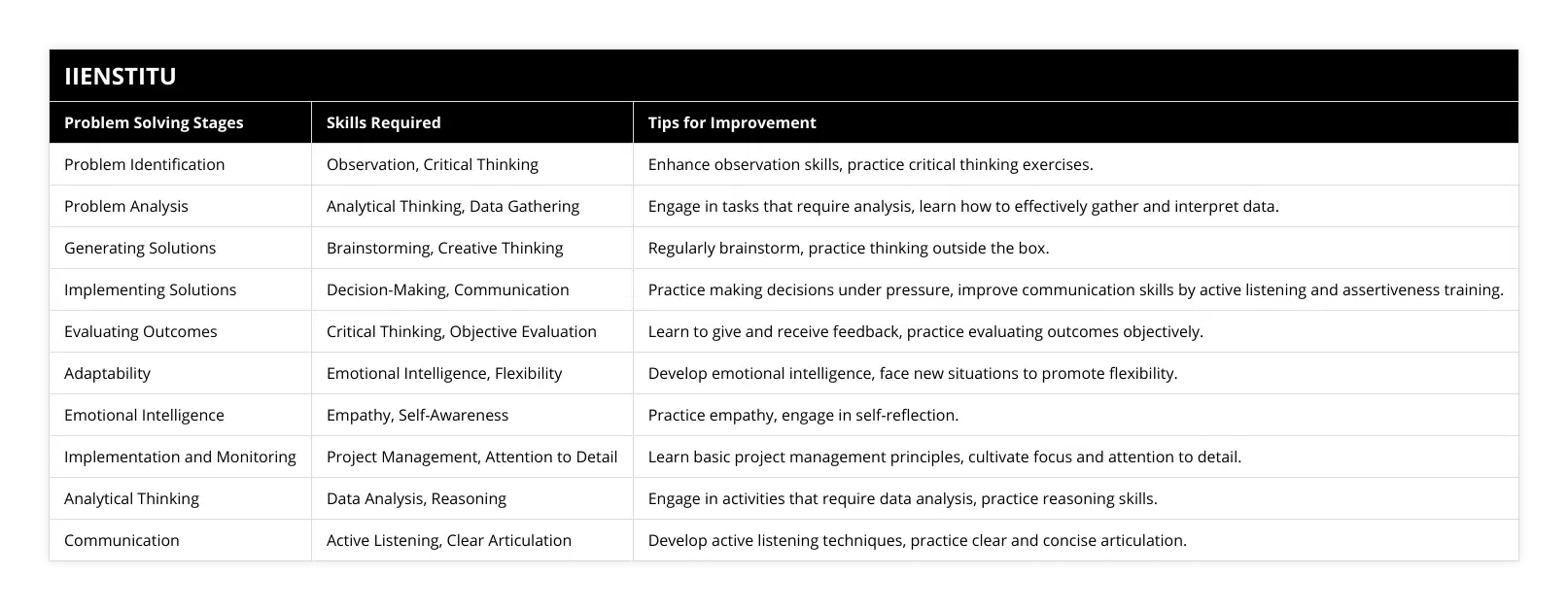
Frequently Asked Questions
How can you develop an action plan for implementing and evaluating your chosen solution using the six-step problem-solving guide?
To develop an action plan for implementing and evaluating your chosen solution using the six-step problem-solving guide, follow these steps:
Revisit your chosen solution from Step 4 and outline the specific actions required to implement it. Break down the key into smaller, manageable tasks.
Assign responsibilities for each task to the relevant individuals or teams. Clearly define their roles and expectations to ensure accountability and commitment.
Develop a timeline for each task, considering any dependencies or prerequisites. This will help you prioritize tasks and monitor progress over time.
Allocate necessary resources, such as budget, tools, and personnel, to support the implementation of the solution effectively and efficiently.
Establish performance indicators or success criteria that will allow you to measure the effectiveness of your solution once implemented. These indicators should be aligned with the initial problem and the goals you aim to achieve.
Communicate the action plan to all relevant stakeholders, ensuring they understand their roles and the overall objectives. This will promote collaboration and facilitate a smoother implementation process.
Regularly monitor the progress of your action plan, making adjustments as needed to address any unforeseen challenges or changes in circumstances. Keep stakeholders informed of any updates or modifications.
After implementing the solution, evaluate its effectiveness by comparing the results with the established performance indicators or success criteria. Reflect on the process, identify lessons learned, and apply these insights to improve future problem-solving efforts.
By following these steps, you can develop a comprehensive action plan that ensures your chosen solution's successful implementation and evaluation within the context of the six-step problem-solving guide.
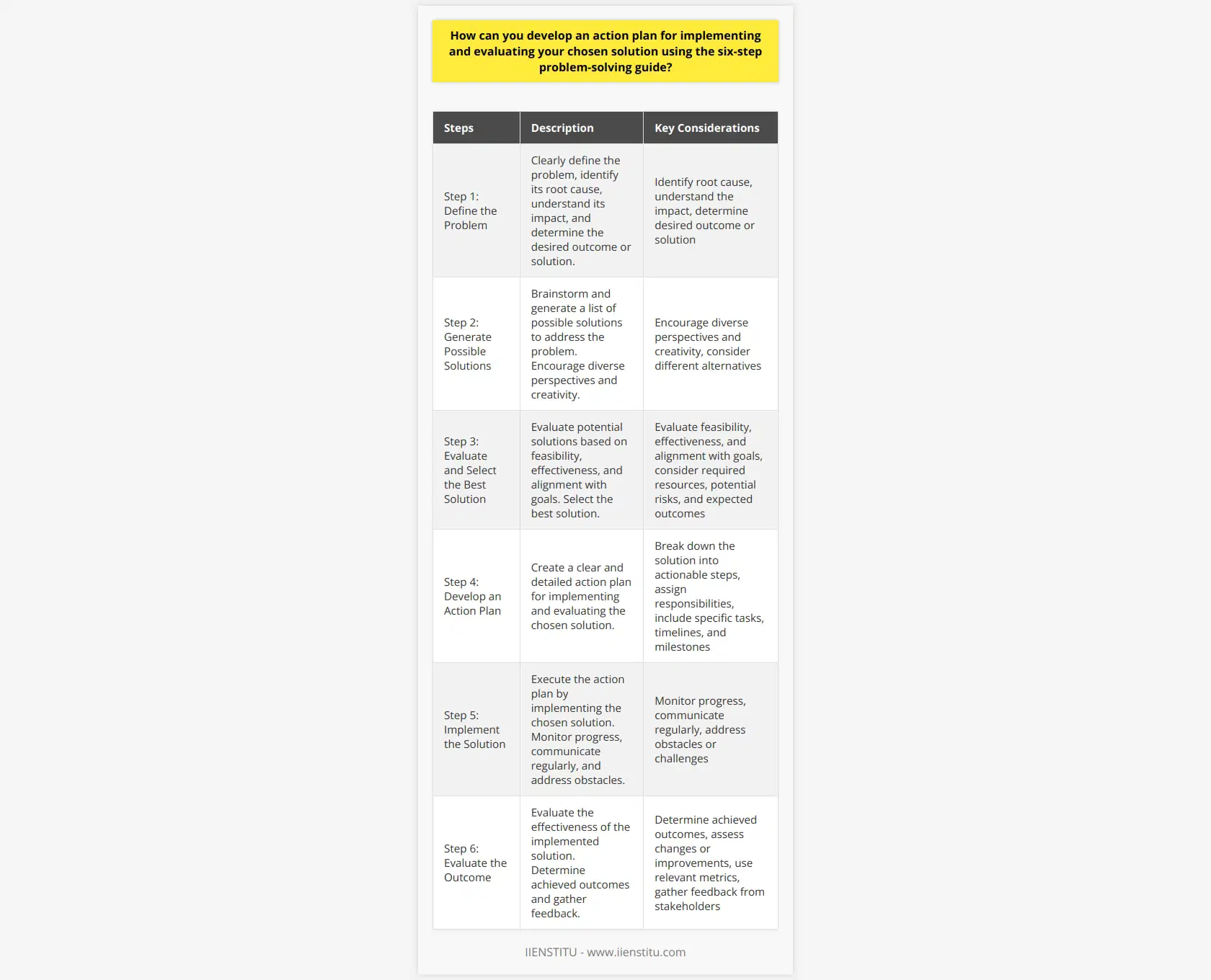
How can we effectively integrate problem-solving techniques into our daily routines to overcome challenges and improve decision-making in our personal and professional lives?
To effectively integrate problem-solving techniques into our daily routines, we can follow these practical steps:
Cultivate mindfulness: Begin by developing an awareness of the challenges and decisions you face daily. This heightened sense of mindfulness will help you recognize opportunities to apply problem-solving techniques in various aspects of your life.
Embrace a structured approach: Adopt the six-step problem-solving process outlined earlier, and apply it consistently across personal and professional challenges. This structured approach can help you address issues systematically, leading to more informed and practical solutions.
Develop critical thinking habits: Cultivate the habit of questioning assumptions, evaluating evidence, and considering multiple perspectives when facing daily challenges. Necessary thinking skills are essential for effective problem-solving and can be developed through practice and reflection.
Practice active listening: When engaging with others, practice active listening to understand their concerns and ideas thoroughly. This can help you identify potential problems and develop collaborative solutions daily.
Allocate time for reflection: Set aside time each day to reflect on the challenges you've encountered and your decisions. This daily reflection will help you identify patterns, improve your problem-solving skills, and make better choices.
Learn from mistakes: Embrace a growth mindset and view failures or setbacks as opportunities for learning and growth. You can continuously improve your problem-solving abilities by analyzing mistakes and adjusting your approach daily.
By incorporating these habits and practices into your daily routine, you can effectively integrate problem-solving techniques and enhance your ability to tackle challenges and make better decisions in both your personal and professional life.
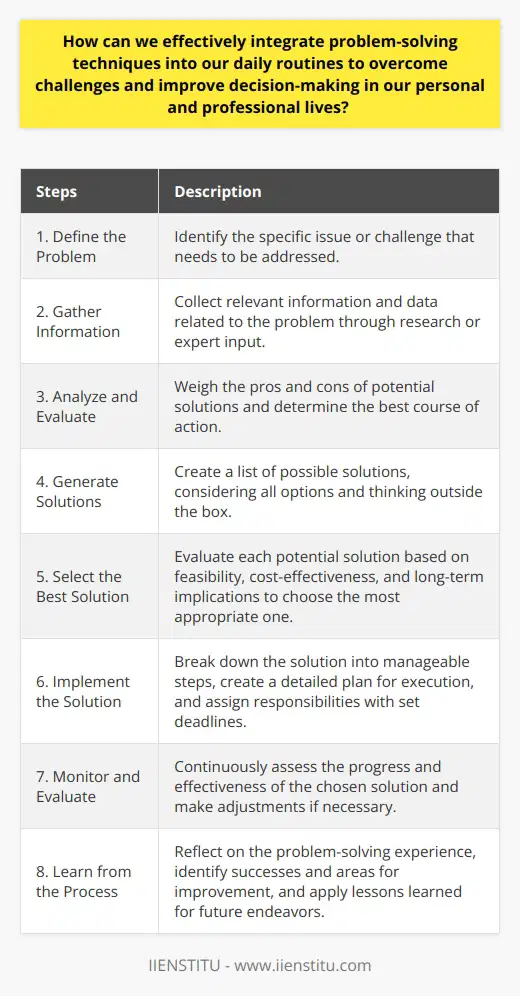
How can a problem-solving team apply the six-step guide to tackle complex challenges and enhance overall team performance?
A problem-solving team can apply the six-step guide effectively by fostering clear communication, collaboration, and diverse perspectives. By defining the problem collectively, generating a wide range of possible solutions, evaluating alternatives as a team, deciding on the most suitable solution, implementing it together, and assessing the outcome, the problem-solving team can leverage their unique strengths and expertise to overcome complex challenges and enhance overall team performance.
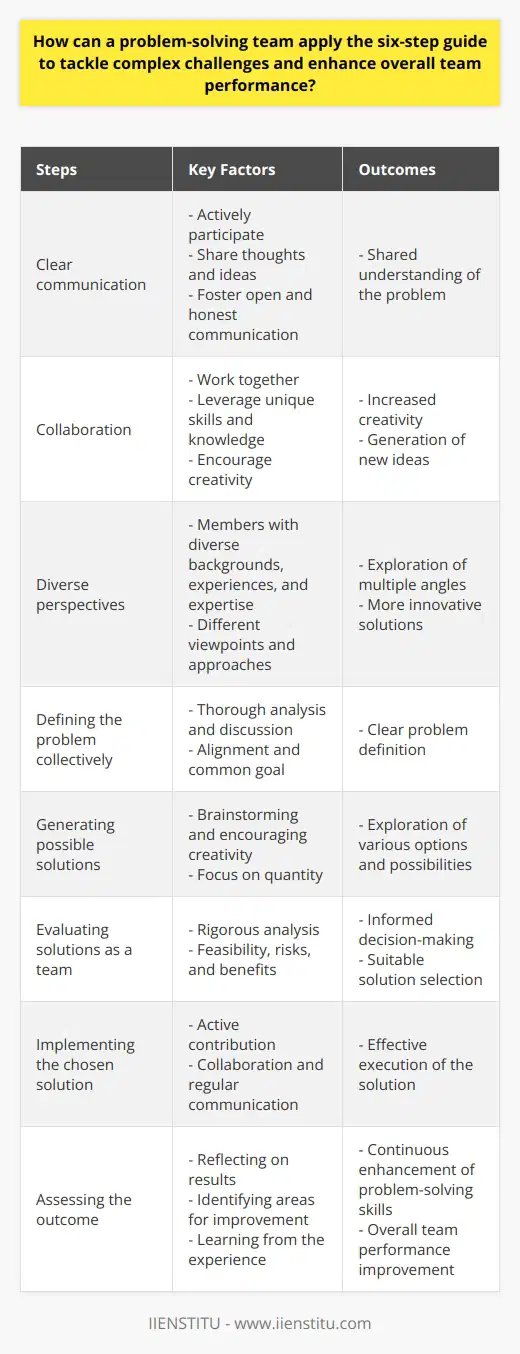
Do you have any suggestions for tools we can use for problem-solving?
Certainly! Numerous tools and techniques can be employed to support problem-solving efforts. Here are some popular options:
Brainstorming: A creative technique that encourages open and free-flowing idea generation, helping to identify a wide range of potential solutions.
Mind Mapping: A visual tool that helps organize and structure information, enabling you to explore the relationships and connections between different ideas and aspects of a problem.
SWOT Analysis: A strategic planning method that assesses the strengths, weaknesses, opportunities, and threats related to a specific problem or situation, aiding decision-making and planning.
Root Cause Analysis: A technique used to identify the underlying causes of a problem rather than focusing solely on the symptoms. Tools like the 5 Whys and Fishbone Diagram (Ishikawa) can be helpful in this process.
Decision Matrix: A tool that helps prioritize and evaluate different solutions based on specific criteria, such as cost, time, and impact, enabling you to make more informed decisions.
Six Thinking Hats: A technique developed by Edward de Bono that promotes structured and parallel thinking, encouraging individuals to approach problems from different perspectives.
SCAMPER: An acronym for Substitute, Combine, Adapt, Modify, Put to another use, Eliminate, and Reverse, SCAMPER is a creative tool that prompts you to think about a problem or idea from different angles, generating innovative solutions.
Cost-Benefit Analysis: A financial tool that compares the costs and benefits of different solutions, helping you determine the most economically viable option.
Pareto Analysis (80/20 Rule): A technique used to prioritize problems or solutions based on the principle that 80% of the effects come from 20% of the causes.
Pro-Con List: A simple yet effective tool to weigh the pros and cons of different solutions, facilitating objective decision-making.
Incorporating these tools and techniques into your problem-solving process can enhance your ability to analyze challenges, generate innovative solutions, and make more informed decisions.
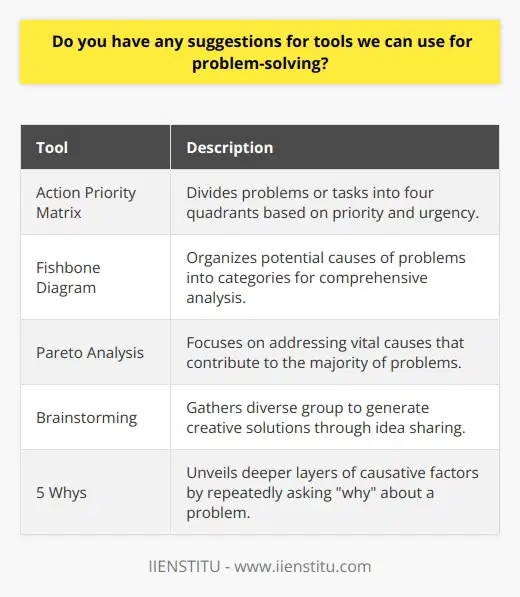
How can cognitive biases impact the effectiveness of the six-step problem-solving process, and what strategies can be employed to minimize their influence on decision-making?
Cognitive biases can impact the effectiveness of the six-step problem-solving process by leading to errors in judgment, flawed assumptions, and suboptimal solutions. To minimize their influence on decision-making, consider the following strategies:
Be aware of common cognitive biases, such as confirmation bias, anchoring, and availability heuristics, and actively question your assumptions and beliefs.
Encourage diverse perspectives and opinions to counteract groupthink and individual biases.
Test your assumptions and solutions against objective criteria, data, and evidence.
Engage in critical thinking and reflective practices to challenge your thought processes and recognize potential biases.
Seek external input or feedback to gain a fresh perspective and identify blind spots in your reasoning.
By employing these strategies, you can mitigate the impact of cognitive biases on the problem-solving process and make more informed objective decisions.
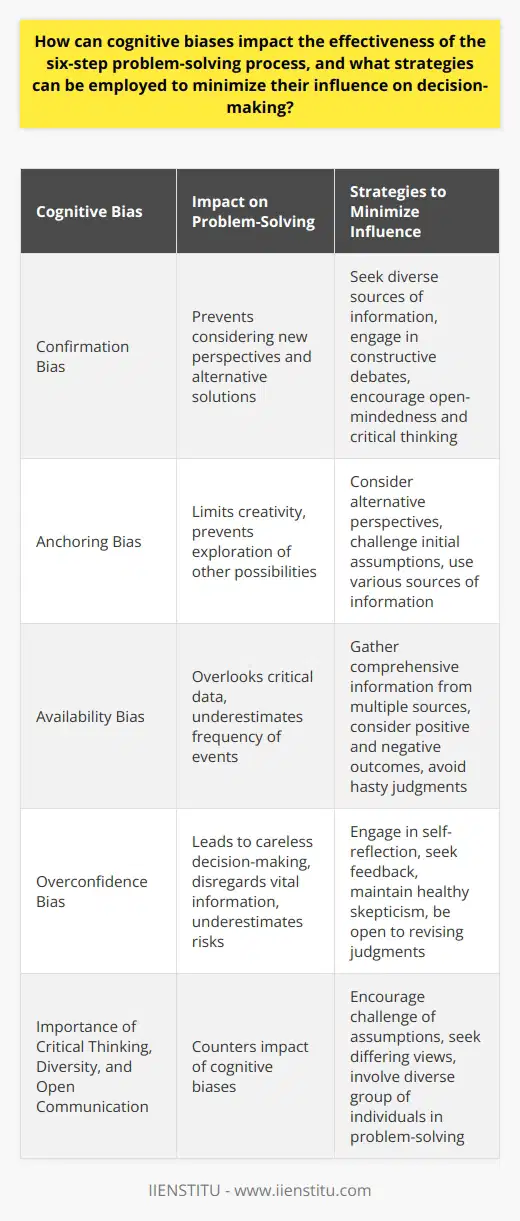
Considering the various problem-solving techniques and strategies discussed in our blog post, how can individuals and organizations effectively apply these methods to address common issues they may encounter in their respective sectors?
Individuals and organizations should identify and understand the challenges specific to their respective sectors to effectively address common issues using the problem-solving techniques and strategies discussed. By applying a structured problem-solving approach, such as the six-step guide, they can systematically analyze the issue, generate creative solutions, evaluate alternatives, and implement the most appropriate solution. Adapting these methods to the unique context of their sectors enables them to tackle common issues more efficiently and successfully.
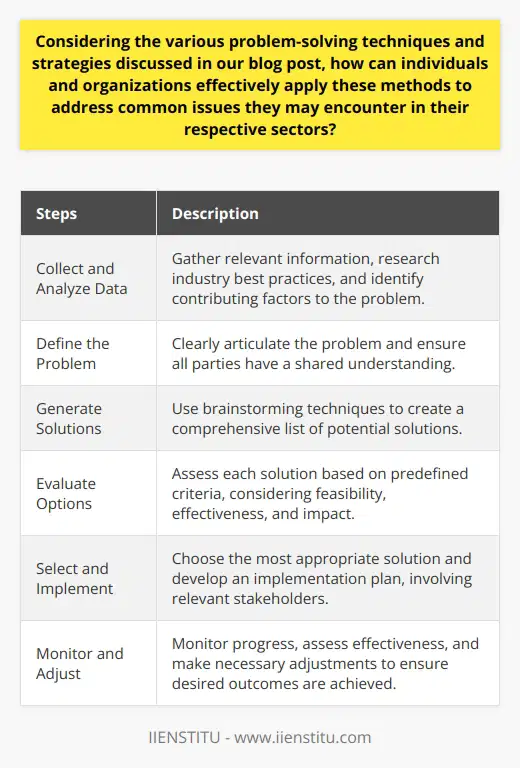
Considering the six-step problem-solving process discussed in our blog post, how can you effectively address coolant issues in a vehicle by applying these techniques?
To effectively address coolant issues in a vehicle using the six-step problem-solving process, follow these steps:
Define the problem: Identify the coolant issue, such as leaks, overheating, or contamination, and consider any contributing factors, like maintenance history or external conditions.
Generate possible solutions: Brainstorm potential fixes, such as repairing leaks, flushing the system, or replacing components like the radiator or water pump.
Evaluate alternatives: Assess each solution based on cost, time, and potential effectiveness in resolving the coolant issue.
Decide on a solution: Choose the most appropriate solution, considering trade-offs and risks and possibly combining multiple solutions if necessary.
Implement the solution: Carry out the chosen repair or maintenance procedure, following proper guidelines and safety measures.
Evaluate the outcome: Monitor the vehicle's performance to ensure the coolant issue is resolved, and make adjustments or revisit the problem-solving process if needed. Reflect on the experience to improve future problem-solving efforts.
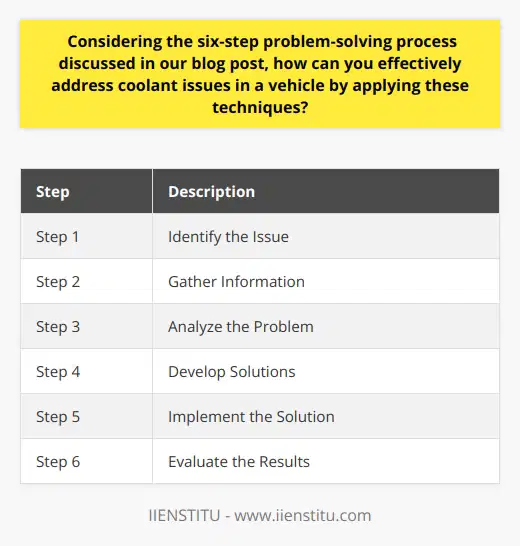
How do mental illness and mental processes influence an individual's problem-solving abilities, and what strategies can be employed to mitigate their effects?
While I am not a mental health professional, I understand the importance of addressing the impact of mental illness and mental processes on problem-solving abilities. Therefore, consulting with a mental health expert is crucial to gain a more comprehensive understanding of these factors and their implications. First, however, I can provide a brief explanation of the topic.
Mental illnesses, such as depression, anxiety, or bipolar disorder, can significantly impact an individual's cognitive functioning and mental processes, including attention, memory, and decision-making. These factors, in turn, can affect one's ability to solve problems effectively. For instance, someone experiencing depression might struggle with concentration, motivation, or evaluating potential solutions. In contrast, a person with anxiety may experience difficulty in making decisions due to fear of failure or negative outcomes.
It is essential to seek support from a mental health professional, such as a therapist, psychologist, or psychiatrist, to address mental illnesses and their impact on problem-solving abilities. These experts can provide tailored guidance, resources, and interventions to help individuals manage their mental health and improve their cognitive functioning.
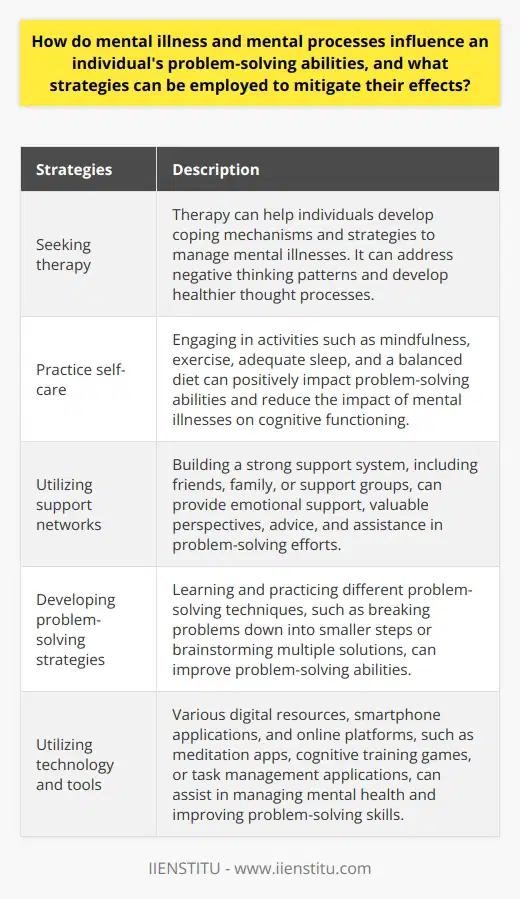
Can you provide detailed instructions on effectively implementing the chosen solution in a specific industry or context?
To provide detailed instructions for effectively implementing a chosen solution in a specific industry or context, follow these steps:
Adapt the implementation plan to the unique characteristics and requirements of the industry or context.
Ensure that the required resources, such as personnel, materials, and finances, are available and allocated appropriately.
Establish clear communication channels with stakeholders and keep them informed throughout the implementation process.
Define industry-specific performance indicators to monitor progress and measure success.
While implementing the solution, address any challenges, barriers, or regulations specific to the industry or context.
Continuously evaluate the solution's effectiveness within the industry or context and make necessary adjustments based on feedback and results.
Remember, the key is to tailor the implementation process to the specific requirements and constraints of the industry or context to ensure the chosen solution's effectiveness and success.
